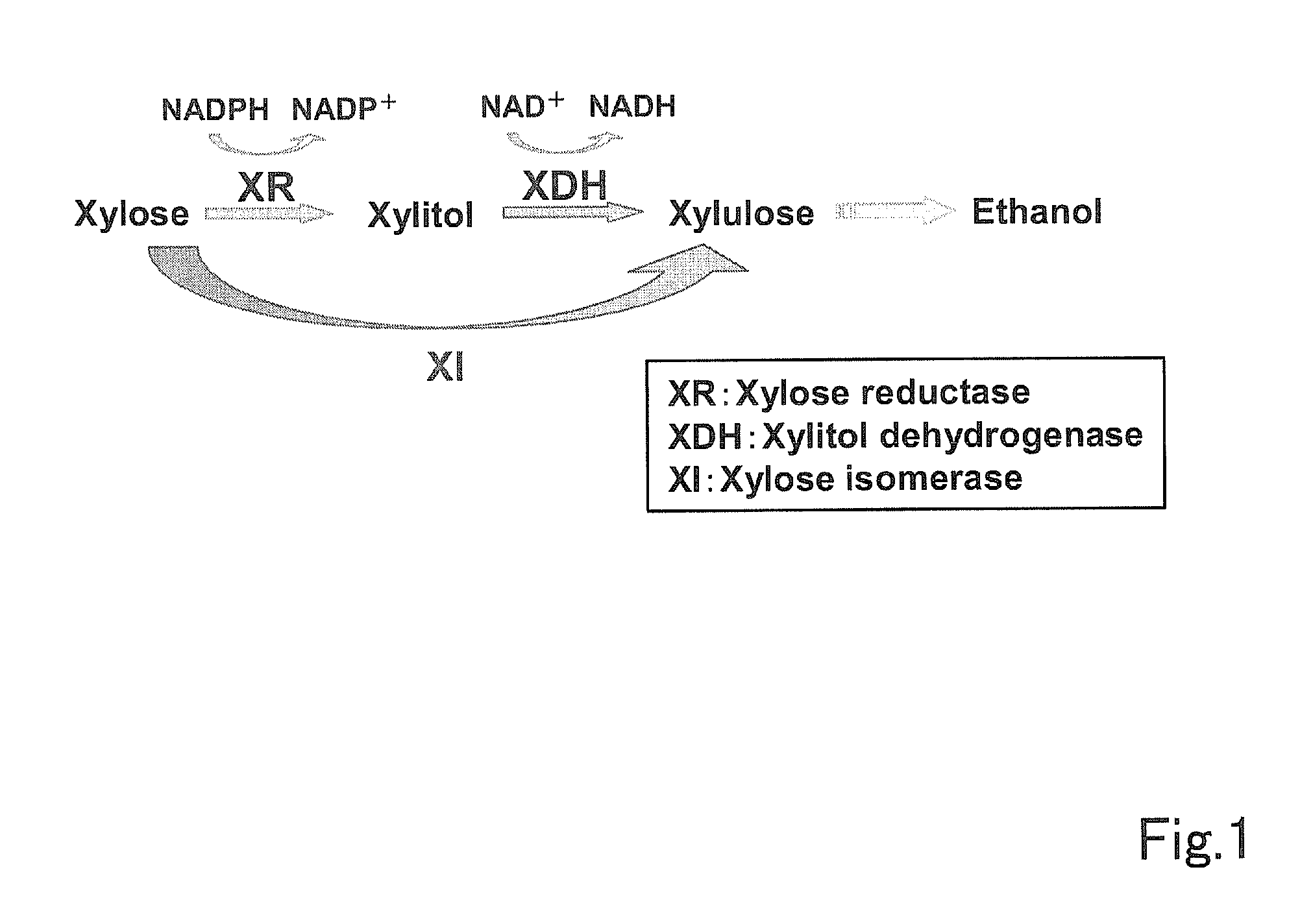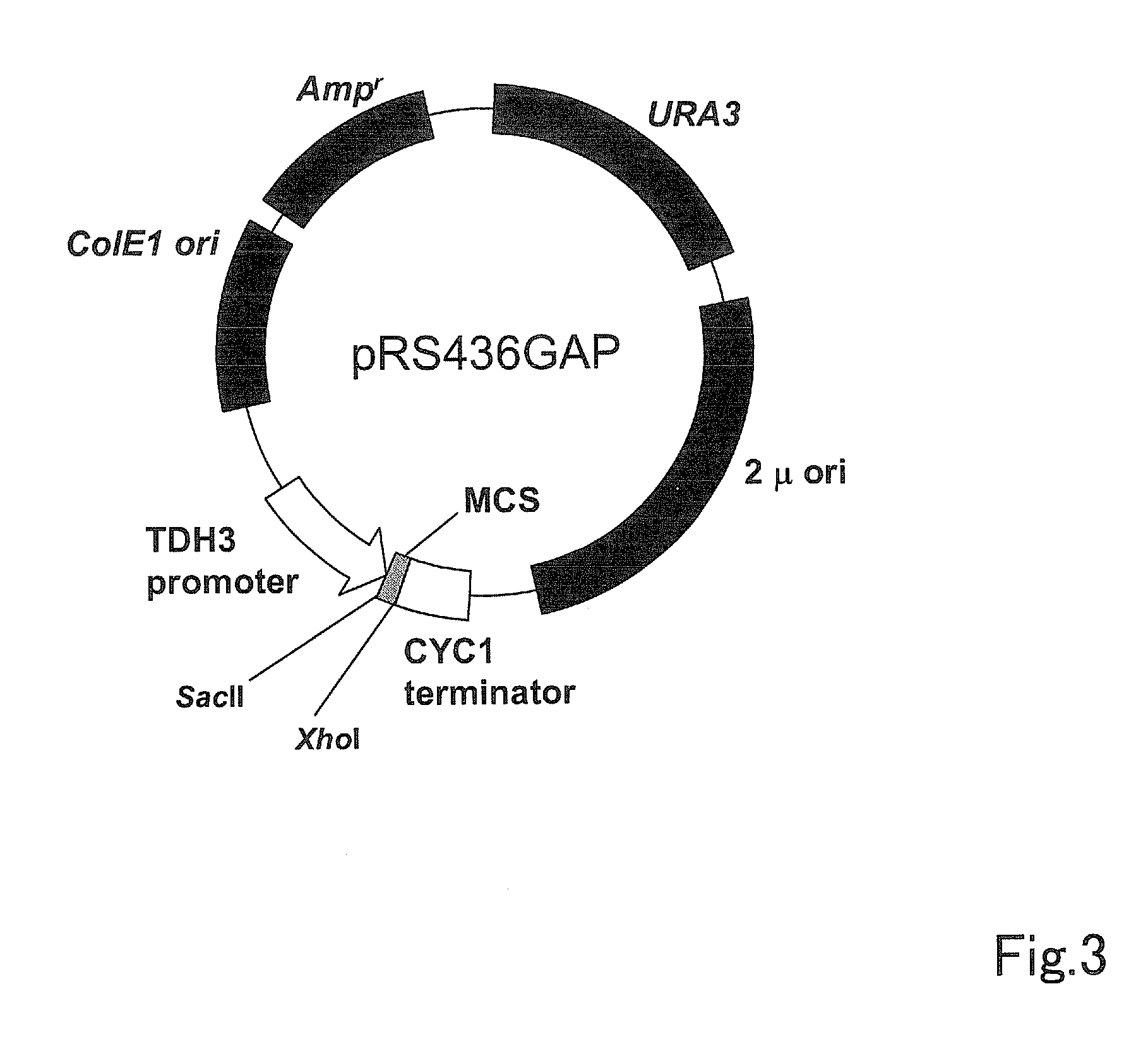Xylose isomerase and use thereof
a technology of isomerase and xylose, which is applied in the field of xylose isomerase, can solve the problems of not knowing whether the original xi activity would be retained, and no xylose isomerase of a termite protist has been discovered, and it is extremely difficult to predict whether this activity will be retained
- Summary
- Abstract
- Description
- Claims
- Application Information
AI Technical Summary
Benefits of technology
Problems solved by technology
Method used
Image
Examples
example 1
Obtaining Genes from Reticulitermes speratus Intestinal Protist cDNA Library
[0139]Xylose isomerase-like genes were obtained from a Reticulitermes speratus intestinal protist metagenomic cDNA library. FIG. 2 shows the experimental procedures. Procedures i) through vi) in FIG. 2 are explained in sequence below.
[0140]i) Using the Reticulitermes speratus intestinal protist metagenomic cDNA library described in Japanese Patent Application No. 2007-053122 as a template, full-length cDNA inserted into a library vector using primers Lib-F and Lib-R was amplified by PCR to prepare an amplified cDNA library. The PCR reaction was performed under conditions of [98° C. 10 sec, 55° C. 15 sec, 72° C. 2 min]×30 cycles using PrimeSTAR HS DNA Polymerase (Takara Bio). The primers are shown below.
Lib-F:(SEQ ID NO: 15)5′-taaacacacataaacaaacaaacccctcgagttaattaaattaatccccc-3′Lib-R:(SEQ ID NO: 16)5′-ttactcctcgagggccacataggccgagctctttttttttttttttt-3′
[0141]ii) Using the resulting PCR product as a template, P...
example 2
Obtaining Genes from Mastotermes darwiniensis Intestinal Protist
[0152]Xylose isomerase-like genes were obtained from a Mastotermes darwiniensis intestinal protist. The test procedures are shown in FIG. 5 below. The procedures i) through iii) in FIG. 5 are explained in sequence below.
[0153]i) Three different genes corresponding to xylose isomerases were confirmed as a result of a homology analysis using partial sequences from the Mastotermes darwiniensis intestinal protist cDNA library described in Japanese Patent Application No. 2007-053122. However, only the partial sequences of the genes were known, and it was necessary to analyze their full-length sequences. A sequence analysis was therefore performed with the primers M13-F (SEQ ID NO: 19) and M13-R (SEQ ID NO: 20) using the plasmids pGEM-3Zf-Md06BA12, pGEM-3Zf-Md63A19 and pGEM-3Zf-Md63A93 carrying the full lengths of the corresponding genes as the templates.
[0154]The nucleotide sequences of the three genes M XI12, MdXI19 and MdX...
example 3
Preparation of Transformed Yeast
(Preparation of Yeast Expression Vectors for Known Xylose Isomerase Genes)
[0158]Yeast expression vectors pRS436GAP-PiXI, -PdXI and -LbXI (FIG. 7) were prepared for a xylose isomerase gene (PiXI) from Piromyces sp. E2, a xylose isomerase (protein ID: YP—001302175) gene (PdXI) from Parabacteroides distasonis ATCC 8503 having 73% amino acid sequence identity with PiXI, and a xylose isomerase (protein ID: EAQ50619) gene (LbXI) from Leeuwenhoekiella blandensis MED217 having 64% sequence identity. These vectors included gene sequences comprising the TDH3 promoter added to the 5′ end and the CYC1 terminator added to the 3′ end of the inserted gene including PiXI gene, as well as the gene sequence of a yeast autonomous replication factor 2μ ori, and the gene sequence of URA3 as an auxotrophic marker.
(Preparation of Pentose Phosphate Pathway Enhanced Yeast)
[0159]Using the vectors pXhisHph-HOR7p-ScXK, pXAd3H-HOR7p-ScTAL1-ScTKL1 and pXGr3L-HOR7p-ScRPE1-ScRKI1 ex...
PUM
| Property | Measurement | Unit |
|---|---|---|
| Fraction | aaaaa | aaaaa |
Abstract
Description
Claims
Application Information
 Login to View More
Login to View More - R&D
- Intellectual Property
- Life Sciences
- Materials
- Tech Scout
- Unparalleled Data Quality
- Higher Quality Content
- 60% Fewer Hallucinations
Browse by: Latest US Patents, China's latest patents, Technical Efficacy Thesaurus, Application Domain, Technology Topic, Popular Technical Reports.
© 2025 PatSnap. All rights reserved.Legal|Privacy policy|Modern Slavery Act Transparency Statement|Sitemap|About US| Contact US: help@patsnap.com



